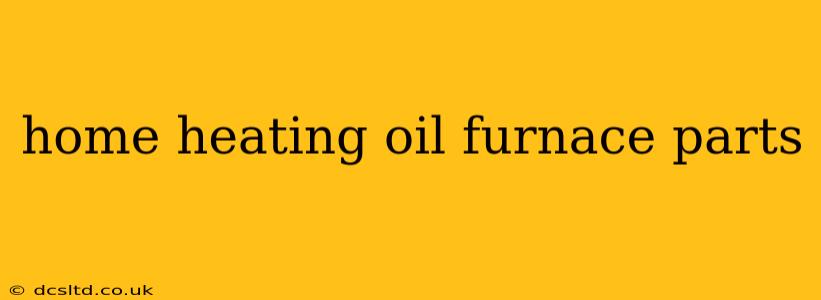Home heating oil furnaces, while reliable, require regular maintenance and occasional part replacements. Understanding the key components and their functions can help homeowners troubleshoot issues, plan for maintenance, and ensure efficient, safe heating. This guide provides a comprehensive overview of common home heating oil furnace parts.
What are the Main Components of a Home Heating Oil Furnace?
A home heating oil furnace consists of several interconnected parts working in harmony to produce heat. The key components include:
-
Burner: This is the heart of the system, where the oil is atomized and ignited. The burner's efficiency directly impacts the furnace's overall performance and fuel consumption. Problems with the burner often manifest as incomplete combustion, leading to soot buildup and reduced heating output.
-
Oil Pump: This pump delivers the correct amount of oil to the burner. A malfunctioning oil pump can lead to inconsistent heating or complete system failure. Regular maintenance, including oil filter changes, helps prolong its lifespan.
-
Ignition System: This system ignites the atomized oil. It typically includes a glow plug or electronic igniter, which requires consistent power and proper functioning. Issues with the ignition system will prevent the furnace from starting.
-
Heat Exchanger: This vital component absorbs the heat generated by the combustion process and transfers it to the air circulating throughout your home. Cracks or leaks in the heat exchanger pose a serious safety hazard due to carbon monoxide (CO) poisoning risk. Regular inspection is crucial.
-
Motor/Blower: This component circulates heated air from the heat exchanger throughout the ductwork and into your living spaces. A malfunctioning blower motor will result in poor air circulation and uneven heating.
-
Oil Filter: This filter removes impurities from the heating oil, protecting the pump and other components from damage. Regular filter replacement is essential for optimal performance and longevity of the system.
-
Pressure Switch: This safety device monitors the air pressure within the furnace. If the pressure is too low or too high, the pressure switch will shut down the system to prevent damage or hazards.
-
Thermostat: This is the control center, allowing you to set your desired temperature and regulate the furnace's operation. A malfunctioning thermostat may lead to inconsistent heating or difficulty in controlling the temperature.
-
Draft Inducer Motor: This motor exhausts combustion gases safely outdoors. A faulty draft inducer can lead to dangerous gas buildup inside your home.
-
Cad Cell: This is a safety device that detects the flame. If the flame goes out, the cad cell signals the furnace to shut down, preventing dangerous gas leaks.
What are the Most Common Problems with Home Heating Oil Furnace Parts?
H2: What are the signs that my home heating oil furnace needs repair?
Several signs indicate potential problems. These include inconsistent heating, unusual noises (bangs, clangs, or hissing sounds), unusual smells (smoke or sulfur), and difficulty starting. A significant drop in heating efficiency, higher-than-normal fuel consumption, or the presence of soot are all serious warning signs.
H2: How often should I replace parts in my oil furnace?
The frequency of part replacement depends on several factors, including usage, the age of the furnace, and the quality of maintenance. However, regular maintenance, including annual inspections by a qualified technician, is crucial for early detection and prevention of problems. Certain parts, like the oil filter, require more frequent replacement than others.
H2: How much does it cost to repair or replace parts in a home heating oil furnace?
Repair and replacement costs vary greatly depending on the specific part, the labor involved, and your location. Minor repairs may be relatively inexpensive, while major component replacements can be significantly more costly. It's always advisable to obtain quotes from multiple HVAC technicians before making any decisions.
H2: How can I prevent my oil furnace from breaking down?
Regular maintenance is key. This includes annual inspections and cleaning by a qualified HVAC technician, regular oil filter changes, and ensuring proper ventilation around the furnace.
By understanding the function of each component and attending to regular maintenance, homeowners can significantly extend the life of their home heating oil furnaces and ensure reliable, efficient, and safe heating throughout the cold seasons. Remember, always consult with a qualified HVAC technician for any repairs or maintenance needs. Safety should always be your top priority when working with heating systems.
